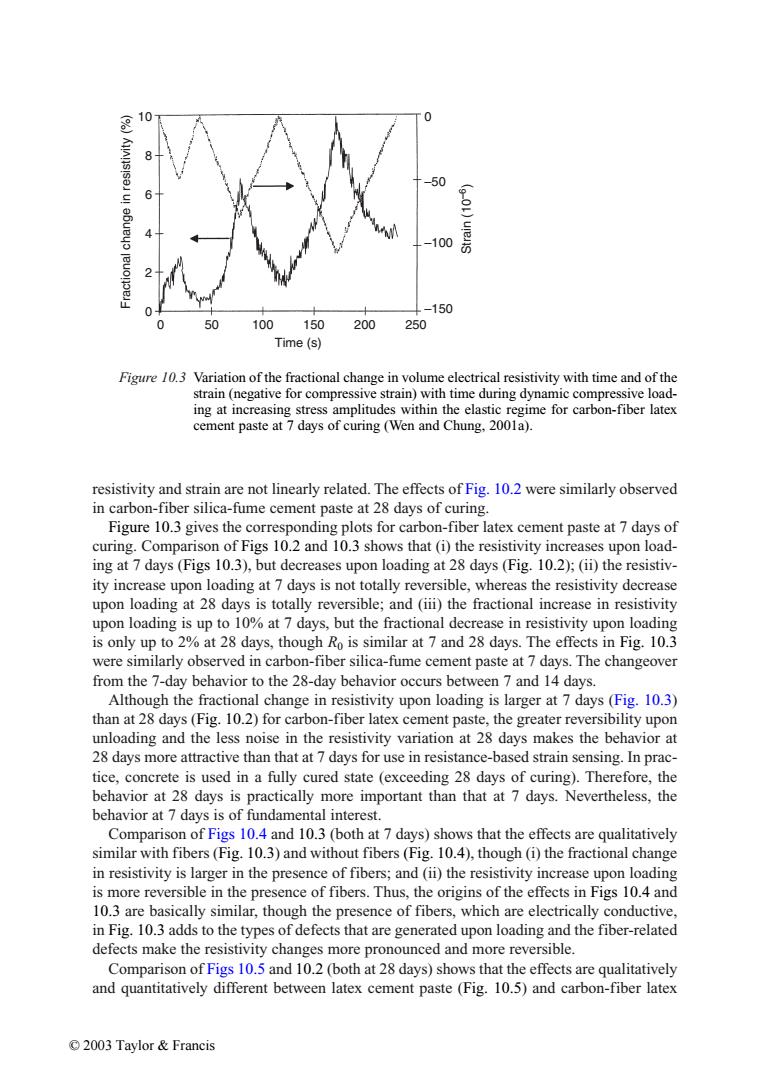正在加载图片...

10 -50 100 -150 50 100150 200 250 Time (s) Figure 10.3 Variation of the fractional change in volume electrical resistivity with time and of the strain(negative for compressive strain)with time during dynamic compressive load- ing at increasing stress amplitudes within the elastic regime for carbon-fiber latex cement paste at 7 days of curing (Wen and Chung,2001a). resistivity and strain are not linearly related.The effects of Fig.10.2 were similarly observed in carbon-fiber silica-fume cement paste at 28 days of curing. Figure 10.3 gives the corresponding plots for carbon-fiber latex cement paste at 7 days of curing.Comparison of Figs 10.2 and 10.3 shows that (i)the resistivity increases upon load- ing at 7 days (Figs 10.3),but decreases upon loading at 28 days(Fig.10.2);(ii)the resistiv- ity increase upon loading at 7 days is not totally reversible,whereas the resistivity decrease upon loading at 28 days is totally reversible;and(iii)the fractional increase in resistivity upon loading is up to 10%at 7 days,but the fractional decrease in resistivity upon loading is only up to 2%at 28 days,though Ro is similar at 7 and 28 days.The effects in Fig.10.3 were similarly observed in carbon-fiber silica-fume cement paste at 7 days.The changeover from the 7-day behavior to the 28-day behavior occurs between 7 and 14 days. Although the fractional change in resistivity upon loading is larger at 7 days(Fig.10.3) than at 28 days(Fig.10.2)for carbon-fiber latex cement paste,the greater reversibility upon unloading and the less noise in the resistivity variation at 28 days makes the behavior at 28 days more attractive than that at 7 days for use in resistance-based strain sensing.In prac- tice,concrete is used in a fully cured state (exceeding 28 days of curing).Therefore,the behavior at 28 days is practically more important than that at 7 days.Nevertheless,the behavior at 7 days is of fundamental interest. Comparison of Figs 10.4 and 10.3(both at 7 days)shows that the effects are qualitatively similar with fibers(Fig.10.3)and without fibers(Fig.10.4),though(i)the fractional change in resistivity is larger in the presence of fibers;and(ii)the resistivity increase upon loading is more reversible in the presence of fibers.Thus,the origins of the effects in Figs 10.4 and 10.3 are basically similar,though the presence of fibers,which are electrically conductive, in Fig.10.3 adds to the types of defects that are generated upon loading and the fiber-related defects make the resistivity changes more pronounced and more reversible. Comparison of Figs 10.5 and 10.2(both at 28 days)shows that the effects are qualitatively and quantitatively different between latex cement paste(Fig.10.5)and carbon-fiber latex ©2003 Taylor&Francisresistivity and strain are not linearly related. The effects of Fig. 10.2 were similarly observed in carbon-fiber silica-fume cement paste at 28 days of curing. Figure 10.3 gives the corresponding plots for carbon-fiber latex cement paste at 7 days of curing. Comparison of Figs 10.2 and 10.3 shows that (i) the resistivity increases upon loading at 7 days (Figs 10.3), but decreases upon loading at 28 days (Fig. 10.2); (ii) the resistivity increase upon loading at 7 days is not totally reversible, whereas the resistivity decrease upon loading at 28 days is totally reversible; and (iii) the fractional increase in resistivity upon loading is up to 10% at 7 days, but the fractional decrease in resistivity upon loading is only up to 2% at 28 days, though R0 is similar at 7 and 28 days. The effects in Fig. 10.3 were similarly observed in carbon-fiber silica-fume cement paste at 7 days. The changeover from the 7-day behavior to the 28-day behavior occurs between 7 and 14 days. Although the fractional change in resistivity upon loading is larger at 7 days (Fig. 10.3) than at 28 days (Fig. 10.2) for carbon-fiber latex cement paste, the greater reversibility upon unloading and the less noise in the resistivity variation at 28 days makes the behavior at 28 days more attractive than that at 7 days for use in resistance-based strain sensing. In practice, concrete is used in a fully cured state (exceeding 28 days of curing). Therefore, the behavior at 28 days is practically more important than that at 7 days. Nevertheless, the behavior at 7 days is of fundamental interest. Comparison of Figs 10.4 and 10.3 (both at 7 days) shows that the effects are qualitatively similar with fibers (Fig. 10.3) and without fibers (Fig. 10.4), though (i) the fractional change in resistivity is larger in the presence of fibers; and (ii) the resistivity increase upon loading is more reversible in the presence of fibers. Thus, the origins of the effects in Figs 10.4 and 10.3 are basically similar, though the presence of fibers, which are electrically conductive, in Fig. 10.3 adds to the types of defects that are generated upon loading and the fiber-related defects make the resistivity changes more pronounced and more reversible. Comparison of Figs 10.5 and 10.2 (both at 28 days) shows that the effects are qualitatively and quantitatively different between latex cement paste (Fig. 10.5) and carbon-fiber latex Figure 10.3 Variation of the fractional change in volume electrical resistivity with time and of the strain (negative for compressive strain) with time during dynamic compressive loading at increasing stress amplitudes within the elastic regime for carbon-fiber latex cement paste at 7 days of curing (Wen and Chung, 2001a). 10 0 –50 –100 –150 8 6 4 2 0 Fractional change in resistivity (%) Strain (10–6) Time (s) 0 50 100 150 200 250 © 2003 Taylor & Francis